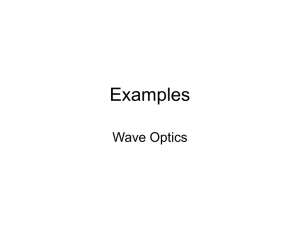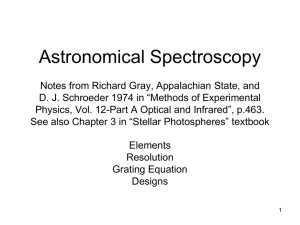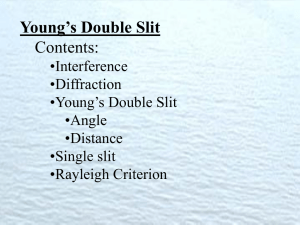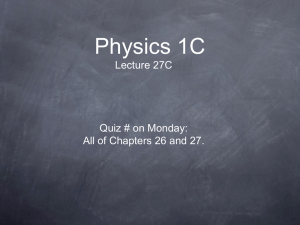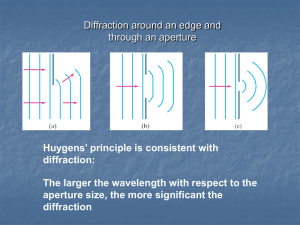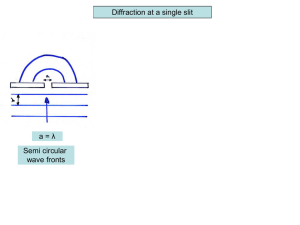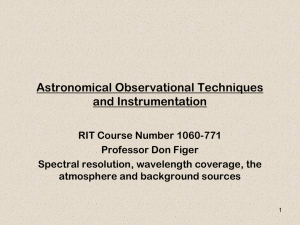Light of wavelength 633 nm is incident on a narrow slit . The angle
advertisement
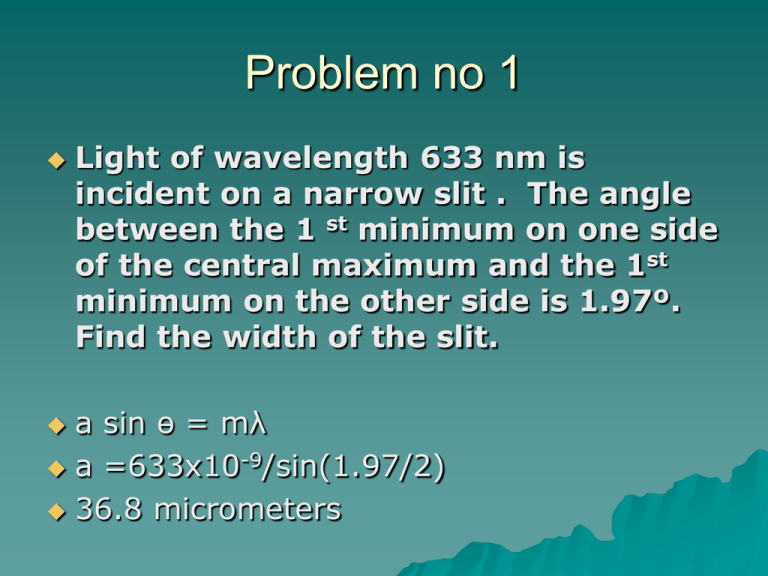
Problem no 1
Light of wavelength 633 nm is
incident on a narrow slit . The angle
between the 1 st minimum on one side
of the central maximum and the 1st
minimum on the other side is 1.97º.
Find the width of the slit.
a sin ө = mλ
a =633x10-9/sin(1.97/2)
36.8 micrometers
2. A monochromatic light of wavelength 441 nm falls on
a narrow slit on a screen 2.16 away, the distance
between the second and the central maximum is 1.62
cm
a. calculate the angle of diffraction of the second
minimum
b. find the width of the slit
a. sinө=ө =d/D=0.0162/2.16 =7.5 x 10-3
b. a sin ө = mλ
On substituting
a=118 µ.m
Problem no 3
A single slit is illuminated by light of wavelength are λa and
λb so coherent that the first diffraction minimum of λa
component coincides with the second minimum of λb
component.
A) what relationship exists between the two wavelengths
B. Do any other minima in the two pattern coincide
SOLUTION:
a sinө =mλ
sin ө =mλ/a
sin өa1 = sin өb2
1λa/a = 2λb/a
λa = 2λb
maλa/a = mbλb/a
mb =2ma
When ever mb is an integer ma is an even integer. i.e. All of the
diffraction minima of λa are overlapped by a minima of λb
Problem no 4
A plane wave, with wavelength
593nm falls on a slit of width 420 µm.
A thin converging lens having a focal
length of 71.4 cm is placed behind the
slit and focuses the light on a screen
Find the distance on the screen from
the center of the pattern to the
second minimum
Solution:
sinө = mλ/a = y/D
y = 2.02 mm
Problem no 5
In a single slit diffraction pattern the
distance between the 1st minimum on
the right and the 1st minimum on the
left is 5.2 mm. The screen on which
the pattern is displayed is 82.3 cm
from the slit and the wavelength is
546 nm calculate the slit width.
sinө =mλ/a =y/D
a = 173 micro meters
Zone plate problems
A zone plate is constructed in such a way that the
radii of the circles which define the zones are the
same as the radii of Newton’s rings formed between
a plane surface and surface having radius o
curvature of 2.0 m. a) Find the primary focal length
of the zone plate and b) secondary focii
Soln;
A. rm2 = mRλ for Newton rings
For m=1, r12 = λR
fm = rm2 / mλ
For m=1, f1 =r12 / λ = λR/λ = R =1m
B. Secondary focii; put r22 and m=2m-1 then we get
R=2R/3= 0.66R m
Zone plate contd….
A point source of wavelength 5000A
is placed 5.0 m away from the zone
plate where central zone has the
diameter 2.3 mm. Find the position of
the primary image.
Soln:
1/f = i/u +i/v = mλ/r m2
For the central zone, m=1, rm = 1.15mm
U=500cm, λ=5x10 -5 cm
Hence v=561.5 cm away from the zone plate
6. The distance between the first and the fifth minima
of a single slit diffraction pattern is 0.350mm With the
screen 41.3 cm away from the slit, using light of
wavelength 546 nm
A. calculate the diffraction angle of the first min
B. find the width of the slit
Solution:
a) a sinө =mλ
ө =sin - λ/a =(546x10 -9m)/2.58x10
=2.12x10 -4rad =1.21x10 -2 degree
b) y/D = (m) λ/a
a = (m) λD/y =(5-1) (0.413) (546x10 -
9)/(0.35x10 -3)
=2.58 mm
-3
m
Problem no 7
If you double the width of a single
slit, the intensity of the central
maximum of the diffraction pattern
increases by a factor of 4 times even
through the energy passing through it
only doubles. Explain qualitatively
Soln:
Doubling the width results in narrowing of
the diffraction pattern As the width of the
central maximum is effectively cut in half,
then there is twice the energy in half the
space, producing four times the intensity
Problem no 8
Calculate approximately the relative intensities of the
maxima in the single slit ,Fraunhofer Diffraction
pattern
Soln:
The maxima lie app half way between the minima and are
roughly given by
= (m=½) where m=1,2,3…..
Iө = Im {sin (m=½)/ (m=½)}2
Iө / Im = {1/ (m=½)}2
=0.0450 for m=1,
=0.0162
=0.0083
=0.0050
=0.0033
for m=2,
for m=3,
for m=4,
for m=5
Problem no 9
In a double slit experiment the distance D of
the screen from the slits is 52cm the
wavelength is 480nm, the slit separation is
0.12mm and the slit width is 0.025mm
A.what is the spacing between adjacent
fringes B.what is the distance from the
cenetral maximum to the first minimum of
the fringe envelope
Soln:
y = λD/d =(480x10 -9) (52x10 -2)/(0.12x10-3) =2.1mm
Angular separation of the first minimum is
sinө =λ/a = 0.0192
Y = D tan ө = D sinө =(52x10 -2)(0.0192) = 10mm
There are about 9 fringes in the central peak of of the diffraction
envelope
Problem no 10
What requirements must be met for the
central maximum of the envelope of the
double slit interference pattern to contain
exactly 11 fringes? How many fringes lie
between the first and the second minima of
the envelope?
Soln:
The required condition will be met if the 6 th min of the
interference factor (cos2β) coincide with the 1st minimum of
the diffraction factor (sin/)2.
The sixth minimum of the interference factor occur when
d sinө = 11λ/2 or β = 11/2.
The
first minimum in the diffraction term occurs for
dsinө = λ
Or = and d/D = 11/2 or d=5.5
Problem no 11
A. Design a double slit system in which the 4th fringe
not counting the central maximum is missing.
B. what other fringes if any are also missing?
Soln:
A.
d sinө =4λ gives the location of the 4th interference maximum.
a sinө =λ, gives the location of the first diffraction minimum.
If d = 4a, there will be no 4th interference maximum.
B.
d sinөmi = mmiλ gives the location of the mth interference
maxima.
d sinөmd = mmdλ gives the location of the m th diffraction minima
D=4a hence if m i =4md there will be a missing maxima
Problem no 12
The wall of large room is covered with
acoustic tile in which small holes are drilled
5.2mm from the center to the center. How
far can a person be from such a tile and still
distinguish individual holes assuming ideal
condition? Assume the diameter of the pupil
of the observer’s eye to be 4.6mm and the
wavelength to be 542nm .
Sol:
y/D = 1.22λ/a (here a=4.6mm and y=5.2mm)
D = 36.2m
Problem no 13
The two head lights of an approaching automobile
are 1.42 m apart . At what
A) angular separation and
B) maximum distance will the eye resolve them?
Assume a pupil diameter of 5 mm and a wavelength
of 562 nm. Also assume that the diffraction effects
alone limit the resolution.
Solution:
A. least angular separation required for the resolution is
өR = sin -1(1.22λ/a) =1.37 x 10-4 rad
өR =y/D =1.42/D=1.37x10 -4 rad.
D=1.04X 104
Diffraction grating problems
A certain grating has 104 slits with a spacing d=2100 nm. It is
illuminated with a light of wavelength 589 nm .
Find
A) The angular positions of all principal maxima observed and
B) the angular width of the largest order maximum.
Soln:
A. d sinө = mλ
sinө = m (589 x 10 -9m)/(2100 x 10 -9m)
For m = 1, ө1 = 16.3
For m = 2, ө2 = 34.1
For m = 3, ө3= 57.3
For m = 4, ө4= more than 90 degree hence 3.0 order is the
highest
B) for m=3, ө = λ / Nd cosө= 5.2 x 10-5 rad or 0.0030 degree
Grating contd……
A diffraction grating has 104 ruling
uniformly spaced over 25 mm. It is
illuminated normally using a sodium lamp
containing two wavelengths 589.0 and
589.59 nm.
A. At what angle will the first order
maximum occur for the first of these
wavelengths?
B. what is the angular separation between
the first order maxima for these lines. Will
this alter in other orders.
A. ө = sin-1 mλ/d =13.6 degrees
B. dө = mλ/ d cos ө =2.4 x 10-4 rads or 0.014
degrees.
As the spectral separation increases with the order no.
this value increases with the order no.
A diffraction grating has 1.2 x 104 rulings uniformly spaced over a width w=
2.5 cm and is illuminated normally using sodium light containing two
wavelengths 589 and 589.59nm.
A. at what angle does the first order maximum occur for the first of these
wavelengths
B. what is the angular separation between these two lines in the first and
the second orders
C. how close in wavelength can two lines be in the first order and өλ
still be resolved by this grating
D. how many rulings can a grating have and just resolve the sodium
doublet lines.
soln:
A.
ө = sin-1 (mλ/d) = 16.4 degrees
B.
Dispersion D = ө/λ = m /(d cosө ) =5.0 x 10-4 rad/nm
ө = D x λ =2.95 x 10-4 rads or 0.0169 degrees
C.
Resolving power = Nm = 1.2 x 10 4
λ =λ/R =0.049 nm hence can resolve the D lines.
D. R =λ/λ = 998. Hence no. of rulings needed is N=R/m =998/1=998 hence can
easily resolve as it has 12 times no, of rulings in it.
Grating contd……
A grating has 200 ruling/mm and principal
maximum is noted at 28 degrees. What
are the possible wavelengths of the
incident visible light
Soln:
λ = (d sinө)/m = 2367 nm for m=1.
On trying for m =4 &5 we get in the visible range
as 589nm and 469 nm and for m=6 and above it
will be in the uv range.
Grating contd……
For a grating the no. of rulings is 350/mm. A white
light falling normally on it produces spectrum 30 cm
from it. If a 10 mm square hole is cut in the screen
with its inner edge 50mm from the central maximum
and parallel to it, what range of wavelengths passes
through the hole?
Soln:
Shortest wavelength passes through at an angle of ө1 = tan -1
(50mm/300mm)= 9.46 degree
λ 1 ={ (1 x 10 -3)sin 9.46} /350 = 470 nm
The longest wavelength that can pass through an angle ө2 =
tan-1(60mm/300mm) = 11.3 degree
This corresponds to a wavelength
Λ 2 = {(1x10 -3 )sin11.3} / 350 = 560 nm
Grating contd……
A
source containing a mixture of
hydrogen and deuterium atoms emit
light containing two closely spaced
red colors at 656.3 nm whose
separation is 0.180 nm. Find the
minimum number of rulings needed
in grating that can resolve these
lines in the first order.
Solns;
N = R/m = λ/mλ =365
Grating contd……
A. How many rulings must a 4.15 cm wide
diffraction grating have to resolve the
wavelengths 415.496 nm and 415.487 nm in
the second order.
B. at what angle are the maxima found
Soln:
N=R/m = λ/mλ = 23100
D = w/N = …..
ө = sin -1 mλ/d = 27.6 degrees
